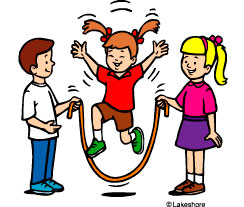So I’ve decided to do a summer video series called “Top 10 Exercises for Runners.” These 10 exercises are things that I am convinced will benefit anyone looking to improve their running. The number one exercise on the top 10 chart is an old school favorite that will take you back to the good old playground days when you were a kid. . . jumping rope. When you realize that running is really just single leg hopping from one leg to the next, over and over again, you see that jumping rope is actually one of the closest activities to running you can get.
Can adults jump rope? Should adults jump rope? Absolutely. A lot of people see jumping rope as a very high impact activity. In reality jumping rope is much easier on the body than running. Both activities involve repeated jumping with lots of forces being exerted on the body with every jump. The main difference between the two activities is that with one you can jump and land wrong repeatedly over and over again without knowing you are doing anything wrong and with the other, you really can’t.
If you can jump rope comfortably for 30 seconds without getting the rope caught up in your feet then chances are your form is optimal. If your posture fails or you don’t land the right way (i.e. landing in a way that optimally distributes load and maximizes energy return) then more than likely you will either 1.) trip over the rope, or 2.) get exhausted after about 10 seconds because you are jumping in a way that is very inefficient. The nice thing about the jump rope is that it will tell you when you are jumping wrong. Unfortunately it isn’t always as easy to tell if you are running wrong. Jumping rope will teach your body two key things: 1.) how to land right, and 2.) how to maintain good posture. By learning this you will get better at distributing load more optimally throughout your body which is extremely important when doing an activity that requires you to absorb over 2.5x your body weight with each “hop” you take (i.e. running). Not only will this help reduce your chances of getting an overuse injury but it will also make you better at storing and releasing energy. The better you are at this, the less effort you will have to put forth to run at a given speed.
Check out my short video link below to see more about this topic. For a review on “correct” running check out the series I did last summer on running mechanics: running mechanics series or check out Chapter 8 of Jay Dicharry’s book “Anatomy for Runners.” ($11 on Amazon if you haven’t bought it yet. . . this one is a must have for all runners!)
Stay tuned for exercise #2. . .


Leave a comment